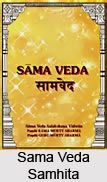 The verses of Sama Veda Samhita are meant to be sung by the Udgatri, who is the Sama Vedic priest as far as sacrifices are concerned. These verses are melodies and they are called the Samans. The Sama veda Samhita are divided into Purvarchika and the Uttararchika.
The verses of Sama Veda Samhita are meant to be sung by the Udgatri, who is the Sama Vedic priest as far as sacrifices are concerned. These verses are melodies and they are called the Samans. The Sama veda Samhita are divided into Purvarchika and the Uttararchika.
Purvarchika is based on the Gramageya and the Aranyaka samans. The Uttararchika is based on the Uha and the Uhya chants. The verses of Gramageya and Aranyageya form the basic collection known as the Prakritigana. There is major difference between the melodies of Purvarchika and Uttararchika. It is that the Purvarchika is constituted on a single verse basis and the Uttararchika is based on units of three verses.
Uttaragana is classified into Uha and the Uhya. Uha is adapted to the Gramageya while Uhya is adapted to Aranyageya. Uha and Uhya ganas of Uttararchika are classified into seven parts and they are Dasharatra, Samvatsara, Ekaha, Ahina, Sattra, Kshudra and Prayaschitta. These categories indicate the manner in which indicate the manner they are executed.
Ranayaniya Samhita appears to be similar to the Kauthuma Sahmita. However its verses differ. Jaiminiya Archika Samhita runs parellel to the Kauthuma Samhita of Samaveda. It has around 1650 mantras and it`s different from the main Kauthuma tradition.
This article is a stub. You can enrich by adding more information to it. Send your Write Up to content@indianetzone.com



















